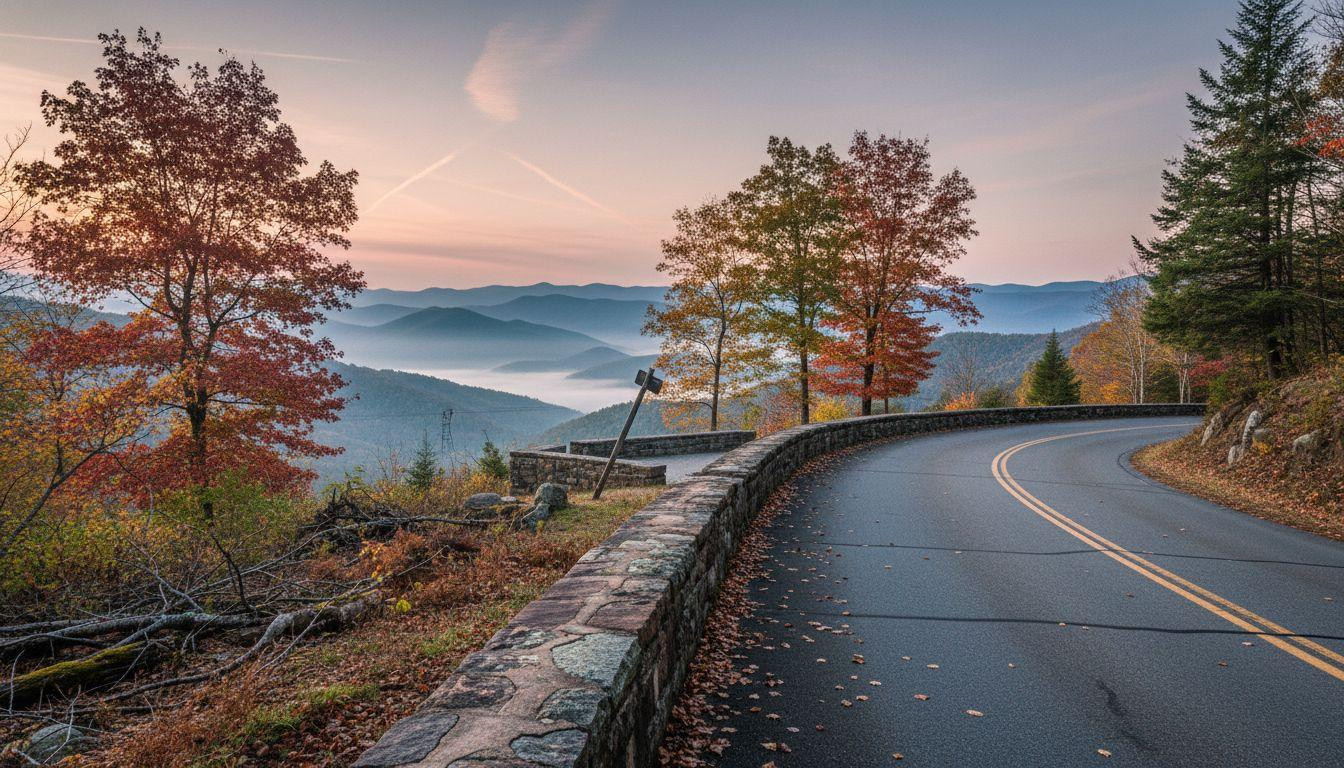Dawn breaks at 6:47 AM as blue mist rises from valleys 2,000 feet below your overlook. The Blue Ridge Parkway curves through ridges that fade into atmospheric haze. The “blue” that names these mountains creates a dreamlike quality. This isn’t another crowded national park charging entrance fees.
This is America’s 469-mile scenic mountain road, free to drive year-round. It winds through elevation zones where autumn colors shift gradually over weeks instead of days. While closures affect sections in November 2025, accessible portions reveal why this engineering marvel took 52 years to complete.
Where ancient mountains meet modern engineering
The Blue Ridge Parkway stretches from Shenandoah National Park in Virginia to Great Smoky Mountains National Park in North Carolina. It connects two major park systems through the spine of the southern Appalachian Mountains. Authorized in 1933 as a New Deal project, construction spanned 1935 to 1987.
The route rises from 650 feet at Virginia’s James River to over 6,000 feet near Mount Pisgah. This creates dramatic elevation-based microclimates within a single drive. Engineering marvels like the Linn Cove Viaduct showcase how builders prioritized preserving landscapes over conquering them.
The parkway receives millions of annual visitors yet remains surprisingly uncrowded in shoulder seasons. Most overlooks offer solitary morning experiences. This road where glaciers catch November light in Montana offers similar elevation-based scenic driving without crowds.
The blue haze and elevation-shifted seasons
Why mountains glow blue at dawn
The distinctive “blue ridge” haze results from terpenes released by millions of trees. These volatile organic compounds scatter light wavelengths, creating soft, dreamlike atmospheric layers. This phenomenon intensifies during humid summer months but persists year-round.
Morning and early evening hours maximize the effect. Distant ridges fade into progressively lighter blue layers. Photography opportunities here are unavailable in western mountain ranges.
Autumn colors that travel downhill
Peak fall foliage occurs mid-to-late October, but the parkway’s elevation range creates a mobile color show. Highest peaks above 4,000 feet reach peak color in late September. Lower elevations between 2,000-3,000 feet peak in early November.
Graveyard Fields consistently shows the earliest and most vibrant colors. This elevation-based progression means a single drive captures multiple seasonal stages. Bare trees at high elevations, peak gold-orange mid-elevation, and lingering green valleys below.
Driving through Appalachian time
Overlooks and hiking trails worth stopping for
The parkway features numerous pullouts offering specific visual experiences. Rough Ridge, Grandfather Mountain, Mount Mitchell, and Waterrock Knob provide highest-elevation viewpoints exceeding 6,000 feet. Linville Falls offers dramatic cascade views accessible via short trails.
The Linn Cove Viaduct itself becomes a destination. This engineering marvel provides aerial views of Grandfather Mountain. Most overlooks remain uncrowded except during peak October weekends. This canyon where a turquoise river cuts through ancient Appalachian rock offers complementary geology experiences in Alabama.
Appalachian heritage sites and local flavors
Historic homesteads, mills, and cultural sites reflect Appalachian heritage dating to the 18th century. The route passes through mountain communities preserving traditional crafts. Quilting, wood carving, pottery, and basket weaving represent authentic arts still practiced by local artisans.
Regional cuisine emphasizes Appalachian staples: fresh mountain trout, cornbread and beans, apple products from fall harvests. Small-town diners and roadside stands offer experiences unavailable in commercialized tourist zones. Local businesses generate 70% of annual revenue during October alone.
November 2025 reality check
As of November 13, 2025, significant sections remain closed due to early winter weather and ongoing Hurricane Helene recovery. Closures span milepost 285.5 in the Boone area through milepost 469 at Great Smoky Mountains entrance. This includes the popular Asheville commuter stretch.
However, Virginia sections and lower North Carolina elevations remain accessible. These offer autumn experiences without peak-season crowds. Spring in April-May may provide superior 2026 planning conditions. Wildflowers emerge, temperatures moderate, and visitor numbers drop dramatically compared to fall.
This hamlet where morning frost settles on stone foundations in Virginia’s Appalachian highlands offers complementary heritage exploration near the parkway.
Your questions about Blue Ridge Parkway answered
When should I visit and what does it cost?
The parkway remains free year-round with no entrance fee. Weather closures affect accessibility November through March at higher elevations. Mid-to-late October offers peak fall foliage but maximum crowds. Early September or late April provide pleasant weather with fewer visitors.
Accommodation costs vary significantly: budget motels $60-100 per night, mid-range hotels $120-200, luxury resorts $250 and up. October rates typically run 20-30% higher than shoulder seasons. Dining averages $12-20 for lunch, $18-35 for dinner at casual restaurants.
How does it compare to other scenic drives?
Unlike Skyline Drive’s 105 miles with a $30 entrance fee, the Blue Ridge Parkway spans 469 miles free of charge. Compared to western mountain routes requiring technical driving skills, the parkway accommodates all driver experience levels. Dense tree coverage creates more intimate, layered, atmospheric views rather than expansive alpine vistas.
This village where Norman stone turns amber in morning light offers historic village exploration as a contrast to driving experiences with similar elevation-based autumn views.
What makes the blue haze unique?
The signature atmospheric effect results from terpenes released by trees. This phenomenon is specific to dense eastern forests. Western mountains lack this haze, creating sharper, clearer distant views instead. The Blue Ridge haze creates painterly, dreamlike layers particularly visible during morning and evening hours.
Steam rises from morning coffee at an empty overlook while blue-hazed ridges fade into distance. The parkway curves ahead, disappearing into mountain folds where elevation will shift seasons again in ten more miles. This is driving as meditation: 469 miles where beauty, not destination, defines the journey.
